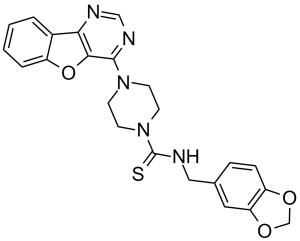Amuvatinib (MP470; HPK56)
This product is for research use only, not for human use. We do not sell to patients.

For small sizes, please check our retail website as below: www.invivochem.com
| Size | Price | Stock |
|---|---|---|
| 250mg | $850 | Check With Us |
| 500mg | $1450 | Check With Us |
| 1g | $2175 | Check With Us |
Cat #: V0579 CAS #: 850879-09-3 Purity ≥ 98%
Description: Amuvatinib (MP-470; HPK-56) is a novel, potent, orally bioavailable and multi-targeted inhibitor of c-Kit, PDGFRα and Flt3 with potential antineoplastic activity.
Top Publications Citing Invivochem Products
Publications Citing InvivoChem Products
Product Promise

- Physicochemical and Storage Information
- Protocol
- Related Biological Data
- Stock Solution Preparation
- Quality Control Documentation
| Molecular Weight (MW) | 447.51 |
|---|---|
| Molecular Formula | C23H21N5O3S |
| CAS No. | 850879-09-3 |
| Storage | -20℃ for 3 years in powder formr |
| -80℃ for 2 years in solvent | |
| Solubility In Vitro | DMSO: 32 mg/mL (71.5 mM)r |
| Water:<1 mg/mLr | |
| Ethanol:<1 mg/mL | |
| Solubility In Vivo | 30% PEG400+0.5% Tween80+5% propylene glycol: 30 mg/mL |
| SMILES Code | S=C(N1CCN(C2=C(OC3=CC=CC=C34)C4=NC=N2)CC1)NCC5=CC=C(OCO6)C6=C5 |
| Synonyms | Amuvatinib; MP470; HPK-56; MP-470; HPK 56; HPK56; MP 470; |
| Protocol | In Vitro | Amuvatinib (MP470) inhibits c-Kit (D816V), c-Kit (D816H), c-Kit (V560G), c-Kit (V654A), PDGFRα (D842V), and PDGFRα (V561D) with IC50s of 950 nM, 10 nM, 34 nM, 127 nM, 81 nM, and 40 nM, respectively. |
|---|---|---|
| In Vivo | Four LNCaP xenograft arms each with 12 mice are dosed intraperitoneally with DMSO (control) or Erlotinib 80 mg/kg or Amuvatinib (MP470) 50 mg/kg or Erlotinib 80 mg/kg plus Amuvatinib 50 mg/kg daily for 2 weeks and then observed for a further 11 days. Individual therapy with Amuvatinib or Erlotinib shows modest tumor growth inhibition (TGI), while Amuvatinib plus Erlotinib has a marked effect on TGI (45-65%). However, due to the high doses of Amuvatinib used, only five or one mouse remained alive in the combination arm at the end of treatment or at the end of the study, respectively. Therefore the Amuvatinib dose is reduced to 10 mg/kg or 20 mg/kg for the combination treatment. TGI in the group receiving 10 mg/kg Amuvatinib+80 mg/kg Erlotinib is not significantly different from the control group. However, mice receiving 20 mg/kg Amuvatinib+80 mg/kg Erlotinib have a significant TGI compared to the control group (p=0.01). |
These protocols are for reference only. InvivoChem does not
independently validate these methods.
| Solvent volume to be added | Mass (the weight of a compound) | |||
|---|---|---|---|---|
| Mother liquor concentration | 1mg | 5mg | 10mg | 20mg |
| 1mM | 2.2346 mL | 11.1729 mL | 22.3459 mL | 44.6917 mL |
| 5mM | 0.4469 mL | 2.2346 mL | 4.4692 mL | 8.9383 mL |
| 10mM | 0.2235 mL | 1.1173 mL | 2.2346 mL | 4.4692 mL |
| 20mM | 0.1117 mL | 0.5586 mL | 1.1173 mL | 2.2346 mL |
The molarity calculator equation
Mass(g) = Concentration(mol/L) × Volume(L) × Molecular Weight(g/mol)
Mass
=
Concentration
×
Volume
×
Molecular Weight*
The dilution calculator equation
Concentration(start)
×
Volume(start)
=
Concentration(final)
×
Volume(final)
This equation is commonly abbreviated as: C1 V1 = C2 V2
Concentration(start)
C1
×
Volume(start)
V1
=
Concentration(final)
C2
×
Volume(final)
V2
Step One: Enter information below
Dosage mg/kg
Average weight of animals g
Dosing volume per animal µL
Number of animals
Step Two: Enter the in vivo formulation
%DMSO
+
%
+
%Tween 80
+
%ddH2O
Calculation Results:
Working concentration:
mg/ml;
Method for preparing DMSO master liquid:
mg
drug pre-dissolved in
µL
DMSO(Master liquid concentration
mg/mL)
,Please contact us first if the concentration exceeds the DMSO solubility of the batch of drug.
Method for preparing in vivo formulation:
Take
µL
DMSO master liquid, next add
µL
PEG300, mix and clarify, next add
µL
Tween 80,mix and clarify, next add
µL
ddH2O,mix and clarify.
Note:
- (1) Please be sure that the solution is clear before the addition of next solvent. Dissolution methods like vortex, ultrasound or warming and heat may be used to aid dissolving.
- (2) Be sure to add the solvent(s) in order.




































